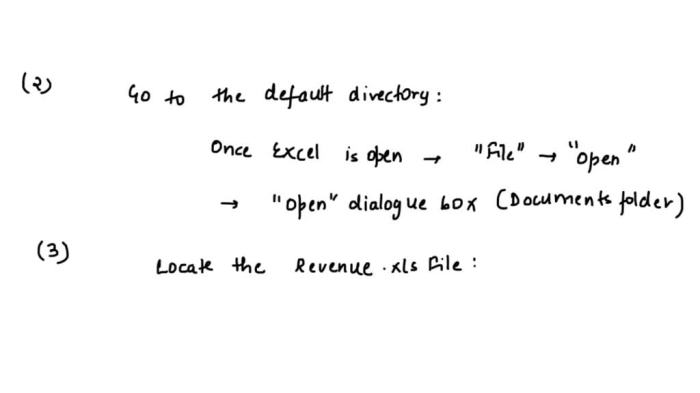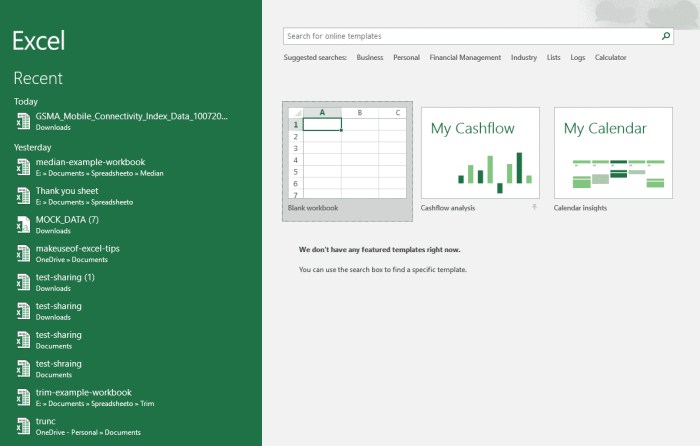Open the excel workbook revenue xls from the default directory – Delving into the realm of Excel automation, we embark on a journey to explore the intricacies of opening the “revenue.xls” workbook directly from the default directory using VBA code. This comprehensive guide will unravel the mysteries of workbook manipulation, empowering you with the knowledge to streamline your workflow and enhance your productivity.
In this discourse, we shall delve into the concept of default directories within Excel, unraveling their significance and providing practical guidance on setting and modifying them. We will dissect the syntax and structure of VBA code specifically tailored for opening workbooks, equipping you with the tools to automate this essential task.
Opening Excel Workbook
Opening an Excel workbook from the default directory involves using VBA code to specify the workbook’s path and filename. The default directory is the location where Excel automatically opens and saves workbooks unless a different directory is specified.
Opening a Workbook from the Default Directory
To open a workbook named “revenue.xls” from the default directory using VBA code, use the following syntax:
Workbooks.Open Filename:="revenue.xls"
Different Methods for Opening Workbooks
- Using the Open Method:Opens a workbook using the Open method of the Workbooks collection.
- Using the File Open Dialog Box:Displays the File Open dialog box, allowing the user to select a workbook.
- Using the Recent Workbooks List:Opens a workbook from the list of recently opened workbooks.
Default Directory

The default directory is the location where Excel opens and saves workbooks by default. It can be set in the Excel Options dialog box under the “Save” tab.
Setting the Default Directory
- Open the Excel Options dialog box.
- Click on the “Save” tab.
- In the “Default file location” field, enter the desired default directory.
- Click “OK” to save the changes.
Changing the Default Directory, Open the excel workbook revenue xls from the default directory
To change the default directory, follow the steps Artikeld above and enter a new directory path in the “Default file location” field.
VBA Code for Workbook Manipulation

VBA (Visual Basic for Applications) code is a programming language used to automate tasks in Excel. It can be used to open workbooks, manipulate data, and perform other operations.
Syntax for Opening Workbooks
The syntax for opening a workbook using VBA code is as follows:
Workbooks.Open Filename:="workbook_name.xls"
Options for Opening Workbooks
- ReadOnly:=True:Opens the workbook in read-only mode.
- Visible:=False:Opens the workbook in hidden mode.
- UpdateLinks:=False:Prevents the workbook from updating external links.
Error Handling

When opening Excel workbooks, errors may occur due to various reasons, such as invalid file paths or permissions issues.
Handling Errors
To handle errors in VBA code, use the “On Error” statement. The following example shows how to handle errors when opening a workbook:
On Error GoTo ErrorHandler Workbooks.Open Filename:="revenue.xls" Exit Sub ErrorHandler: MsgBox "Error occurred while opening the workbook."
Best Practices: Open The Excel Workbook Revenue Xls From The Default Directory
- Use the Default Directory:Opening workbooks from the default directory simplifies the code and avoids potential errors.
- Specify the Workbook Name:Always specify the full workbook name, including the file extension, to avoid ambiguity.
- Handle Errors:Use error handling to gracefully handle errors that may occur during workbook opening.
- Optimize Code:Use efficient coding practices to optimize the performance of VBA code for opening workbooks.
Frequently Asked Questions
How do I open a specific Excel workbook from the default directory using VBA?
To open a specific Excel workbook from the default directory using VBA, you can utilize the following code:
Sub OpenWorkbook()
Workbooks.Open Filename:="revenue.xls"
End Sub
What are the advantages of using VBA to open Excel workbooks?
Using VBA to open Excel workbooks offers several advantages, including:
- Automation: VBA allows you to automate the process of opening workbooks, saving time and effort.
- Customization: VBA provides the flexibility to customize the workbook opening process based on specific requirements.
- Error handling: VBA enables you to handle errors that may occur during the workbook opening process, ensuring a smooth and efficient operation.